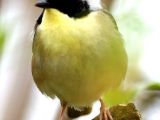Large shoulders, perfect smile, good sense of humor or a trusty person? No matter what makes a man attractive, women worldwide want the same in men. And this rule applies to the animal kingdom as well: all females are attracted by the same male characteristics, specific to a species, no matter if it's about something in the look or the singing skills.
But this is not always the case, and researchers have found for the first time such a case; a clear first step towards speciation, in the case of female yellowthroats. Male yellowthroats possess large black masks and yellow bibs. Yellow/red/orange colors are determined by carotenoids, antioxidant chemicals that act like health signals. Indeed, a team led by Corey Freeman-Gallant, from Skidmore College in Saratoga Springs, New York, discovered in 2001 that New York female yellowthroats were attracted by the males with the brightest yellow bibs, signaling larger amounts of carotenoid.
But also in 2001, a team led by Peter Dunn, from the University of Wisconsin, Milwaukee, found an astonishing fact: Wisconsin yellowthroat females were attracted, in fact, by larger black masks in males. Researchers were puzzled, as the black color of the masks is determined by melanin, which is not an indicator of fitness.
To check these findings, Dunn's team investigated in aviaries yellowthroats from the New York state and from Wisconsin. Females were shown various possible mates, with various mask sizes and bib brightness. The new research, published in the "Journal of Avian Biology", confirmed the population's difference in female sexual choice. The New York state yellowthroats females stared longer at males with large yellow bibs, and the Wisconsin yellowthroats at larger black masks, but the explanation for this is still unknown.
"It's possible that in Wisconsin, masks are an even better indicator of fitness than bibs are, but further research is needed." said Dunn.
"Variation in female preferences for male traits has long been proposed as an evolutionary force that could lead to speciation and such a divergence may be under way in yellowthroats. The first step is to show that female mating preferences do vary geographically," said the evolutionary biologist Michael Webster, of Washington State University in Pullman.

 14 DAY TRIAL //
14 DAY TRIAL // 
